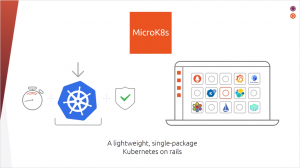by Dr. Robert Buccigrossi, TCG CTO

Canonical (the organization behind Ubuntu Linux) has just announced MicroK8s (Micro-Kubernetes). Why should we care?
Containers Can Make Deployment Easier — Well, speaking as a system administrator, setting up and managing machines is a pain, whether you do it on “bare metal” or “in the cloud” (on virtual machines). This is one reason containers are so compelling. Containers are essentially very light, easy-to-run, and disposable virtual machines. In addition, containers allow the same environment to be run anywhere (locally and across different cloud environments) with little to no reconfiguration.
Kubernetes Coordinates Fleets of Containers — Containers are intended to be small, so to run a full application, you need a collection of them. Then, if you want to scale, you need to be able to coordinate the creation and removal of containers as needed. This requires “container orchestration”, and Kubernetes is one of the most popular container orchestration platforms.
But Kubernetes is Also Difficult to Maintain — However, Kubernetes has its own problems: It is difficult to diagnose when things go wrong. And Upgrading Kubernetes takes planning and care.
MicroK8s to the Rescue — MicroK8s promises to be a “low-ops minimal production Kubernetes, for devs, cloud, clusters, workstations, Edge and IoT.” It provides a simplified interface to configure and run Kubernetes and features “automatic, autonomous and self-healing high availability”. As it turns out, the demand for simplified Kubernetes is so strong that MicroK8s is joining other simplified Kubernetes distributions including k0s (an “all-inclusive Kubernetes distribution” that can be built “simply by copying and running an executable file on each target host”) and k3s (a “certified Kubernetes distribution built for IoT & Edge computing”).
So if you are looking at Kubernetes, consider MicroK8s. But to me, a question remains: Does MicroK8s solve configuration issues with Kubernetes, or just push them deeper under the surface?